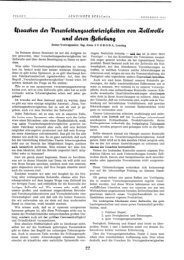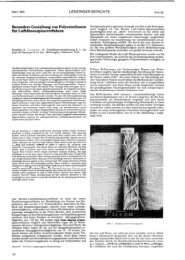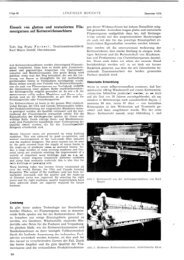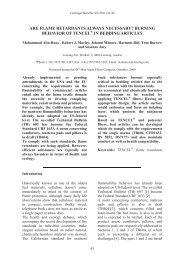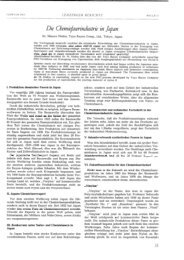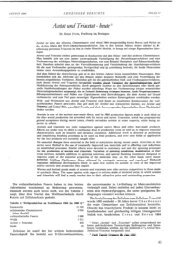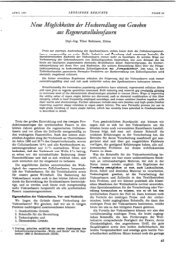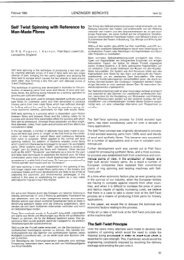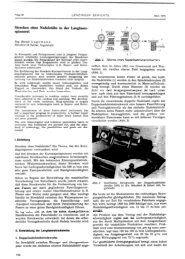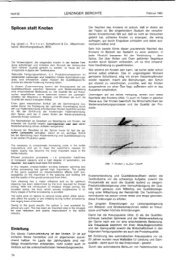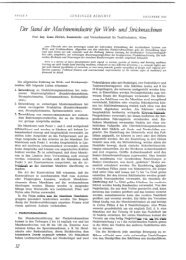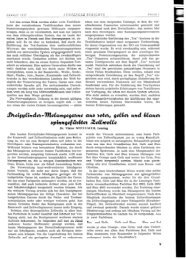Ionic liquid: current developments, potential and ... - Lenzing
Ionic liquid: current developments, potential and ... - Lenzing
Ionic liquid: current developments, potential and ... - Lenzing
You also want an ePaper? Increase the reach of your titles
YUMPU automatically turns print PDFs into web optimized ePapers that Google loves.
that are highly toxic, flammable, <strong>and</strong>/or reactive.<br />
The electronics industry uses toxic gases such as<br />
phosphine (PH3), boron trifluoride (BF3), <strong>and</strong><br />
arsine (AsH3) to dope silicon with phosphorus,<br />
boron, <strong>and</strong> arsenic ions. It was realised that<br />
chemical complexation could be a superior<br />
alternative to physical adsorption <strong>and</strong> that ionic<br />
<strong>liquid</strong>s have properties that are ideally suited for<br />
this application [89, 90]. The solubility of carbon<br />
dioxide in [BuImMe][PF6] <strong>and</strong> [BuImMe][BF4]<br />
was studied [91, 92], <strong>and</strong> enhanced CO2<br />
absorption in poly(ionic <strong>liquid</strong>)s was observed<br />
[93]. It was also found that the nature of the<br />
anion had the most significant influence on the<br />
gas solubilities [94, 95]. The selective <strong>and</strong><br />
reversible oxygen absorption in an IL was<br />
patented [96]. Recently, the solubilities of carbon<br />
dioxide, ethane, methane, oxygen, nitrogen,<br />
hydrogen, argon, <strong>and</strong> carbon monoxide were<br />
compared [97].<br />
Catalytic reactions in ILs<br />
The key to waste minimisation in chemicals<br />
manufacture is the widespread substitution of<br />
classical "stoichiometric" syntheses by atomefficient,<br />
catalytic alternatives. In the context of<br />
homogeneous catalysis, efficient recycling of the<br />
catalyst is a conditio sine qua non for<br />
economically <strong>and</strong> environmentally attractive<br />
processes. Motivated by one or both of the above<br />
issues, much attention has been devoted to<br />
homogeneous catalysis in biphasic systems.<br />
Similarly, the use of ILs as novel reaction media<br />
may offer a convenient solution to both the<br />
solvent emission <strong>and</strong> catalyst recycling problem<br />
[4, 98, 99]. Some unidentified mechanism is<br />
operating in olefin dimerisation [100].<br />
Nonaqueous biocatalysis [101] <strong>and</strong> biochemical<br />
transformations in ILs [102] were reviewed.<br />
Hydroformylation<br />
Hydroformylation of alkenes has excellent<br />
<strong>potential</strong> as a reaction for use with IL systems<br />
allowing continous-flow reactors to be used<br />
[103]. Supercritical fluid-ionic <strong>liquid</strong> biphasic<br />
systems were described for the separation of the<br />
products from the catalyst [104, 105].<br />
Hydrogenation<br />
Increased rates <strong>and</strong> effective recycling of the<br />
catalyst were observed for the rhodium-catalysed<br />
hydrogenation of alkenes in ILs [106, 107].<br />
<strong>Lenzing</strong>er Berichte, 84 (2005) 71-85<br />
75<br />
There has been some speculation that<br />
hydrogenation in ILs is due to colloidal rhodium<br />
particles [108]. Again, temperature-dependent<br />
miscibility <strong>and</strong> phase-separation add to the<br />
opportunities of these processes.<br />
Oxidation<br />
ILs were used for asymmetric epoxidations,<br />
oxidation of alcohols to carbonyl compounds,<br />
<strong>and</strong> PdCl2-catalysed oxidation of styrene to<br />
acetophenone (Wacker process) [109]. The<br />
coordinating ability of the anion was found to<br />
affect the kinetics of these oxidation reactions<br />
[110]. A mixture of [BuImMe][BF4] <strong>and</strong> water<br />
was recycled up to eight times in the<br />
PdCl2/CuCl-catalysed oxidation of terminal<br />
alkenes (with an increase of selectivity in the<br />
case of 4-methylstyrene) [111].<br />
Oligomerisation <strong>and</strong> polymerisation<br />
The high polarity of ILs should make them<br />
attractive solvents for ionic polymerisation<br />
processes [112]. The methodology is still in its<br />
infancy but has great <strong>potential</strong> for the future [99].<br />
Magnetic ILs<br />
Recently, the IL [BuImMe][FeCl4] was<br />
discovered to exhibit an unexpectedly strong<br />
magnetic behaviour [113]. This property may<br />
lead to novel <strong>and</strong> unusual applications.<br />
Brönstedt-acidic systems<br />
A new series of Brönsted acid-base ionic <strong>liquid</strong>s<br />
were derived from the controlled combination of<br />
a monoprotonic acid with an organic base under<br />
solvent-free conditions. Bis(trifluoromethanesulfonyl)amine<br />
(Tf2NH) <strong>and</strong> imidazole were<br />
mixed. The resulting Brönsted acid-base ionic<br />
<strong>liquid</strong> system was investigated as a c<strong>and</strong>idate for<br />
a new proton conductor such as a fuel cell<br />
electrolyte to operate under anhydrous conditions<br />
<strong>and</strong> at elevated temperature [114].<br />
Zwitterionic ILs containing a sulfonic acid group<br />
in a pyridinium cation were successfully<br />
employed for catalytic esterification reactions<br />
[64].<br />
Electrochemistry<br />
Electrochemical aspects <strong>and</strong> applications were<br />
recently reviewed [115]. ILs have clearly<br />
<strong>potential</strong> as conducting media with large<br />
electrochemical windows. For example,<br />
reversible electrochemical deposition of



